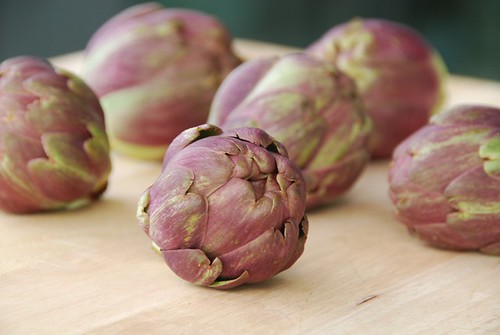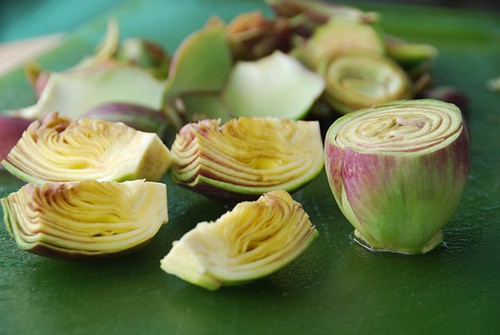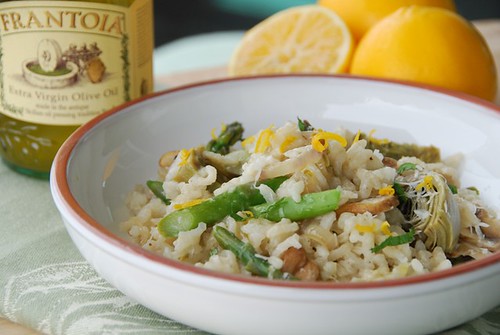
I've always been a big Globe artichoke kind of girl. That was until a couple of years ago when I tried baby artichokes. Now, I have learned to divide my love between them both.
Baby artichokes are fully mature artichokes, as their rich, earthy flavor attests to, but they're picked from the lower part of the plant, where they simply don't develop as much. As a result, the artichoke's characteristic fuzzy choke isn't all that fuzzy and can be eaten. In fact, other than a few tough outer loves, the entire artichoke is edible. So baby artichokes have all the flavor of their larger counterparts but without all the work. That's why they're ideal for a mid-week meal.
Select baby artichokes that are heavy for their size and have tight, firm, green or purple tinged leaves. White or brown streaks indicate frost bite or wind-burn; they are still edible, just unattractive. Do not, however, buy them if they're spongy or appear overly dry, brittle, or pitted. Baby artichokes can be refrigerated for up to 4-5 days, though the sooner you use them the better they'll taste.

Compared to large Globe artichokes, baby artichokes are a breeze to clean. Just cut off the pointy top and the stem. Remove any tough or damaged outer leaves. Cut each artichoke in half or in quarters, and submerge in a bowl of water with lemon juice (this keeps them from oxidizing, or turning brown).
Baby artichokes can be boiled, steamed, braised, roasted, and even grilled. It's a good idea to par-boil them for 2-3 minutes before roasting or grilling which helps them retain more moisture.
Baby artichokes are delicious in everything from antipasto and salads to pastas and pizzas. They seem divined, however, for creamy risotto. This risotto celebrates the flavors of spring with nutty baby artichokes, tender asparagus, and fragrant fresh mint. It is an intoxicating combination of flavors and textures.
I have made it twice already, and now that I'm posting this, Jeff just asked, "Hey, when are you gonna make that risotto again?" Addictive, I tell you. That's why I'm sending it to Anh of the beautiful Food Lover's Journey, this week's host of Weekend Herb Blogging, created by Kalyn of Kalyn's Kitchen.

Baby Artichoke and Asparagus Risotto
Makes 2 main or 4 side servings.
Print recipe only here.
1 teaspoon butter
1 teaspoon olive oil
1 large shallot, diced (about 1/4 cup)
1/2 cup uncooked Arborio rice
2 1/2 cups low-sodium broth, or as much as needed
1/4 cup dry white wine
8 asparagus stalks, cut into 1-inch slices
4 baby artichokes, trimmed and quartered
the juice of 1 lemon (for lemon water)
1 teaspoon olive oil
1 cup cremini mushrooms, sliced
7-8 cranks of freshly ground black pepper
1 tablespoon Meyer lemon juice
1/2 teaspoon lemon zest
5-6 mint leaves, thinly sliced
1/4 cup Parmesan cheese
1 tablespoon butter, optional
In a medium sauce pan over medium heat, add 5 cups of vegetable broth. Heat through for about 10 minutes, then lower to a simmer while cooking the risotto.
Meanwhile, fill a medium sized deep pot with water and the juice of 1 lemon (which prevents the artichokes from oxidizing, or turning brown) and bring to a boil. Trim the thick bottoms of the asparagus, and cut into 1-inch slices. Remove any tough or damaged outer leaves of the artichokes; trim off the tops and the stems, and cut into quarters. Place in a bowl of lemon water (which keeps them from oxidizing, or turning brown). Boil in lemon water for 3 minutes, then add the asparagus, and cook 3 minutes more, or until vegetables are just tender. Drain, and plunge in a bowl of ice water to stop the cooking process.
For the risotto, heat 1 teaspoon of olive oil and 1 teaspoon of butter in a large skillet over medium heat. Add diced shallots and saute 3-5 minutes, or until tender. Add the Arborio rice; toast for about 1 minute. Cook the risotto at a slow simmer, adding heated broth ½ cupful at a time. Most cookbooks will tell to stir continuously; I don’t, and you don't have to either. You can stir occasionally; just make sure the risotto absorbs the liquid before adding more. It will become tender and creamy as it cooks. Season with some salt about halfway through so it blends well, and add the white wine. 5 cups of broth usually works for this recipe, but use more or less as needed. It takes about 20 minutes for the risotto to become completely cooked. Taste it -- it should be wonderfully creamy and thick. It’s best al dente, which means it should still retain some firmness when you chew it.
After about 10 minutes of cooking the risotto, place a large skillet over medium heat. Heat 1 teaspoon of olive oil, then add mushrooms. Saute 5 minutes, or until golden brown; add the drained artichokes and asparagus; cook another 3-5 minutes until vegetables are tender but not mushy. Season with salt and black pepper.
At this point, the risotto should be cooked. Add the sautéed vegetables and stir. Add the lemon juice, lemon zest, and mint; stir until well combined and heated, about 1 minute. Turn off heat; then add the Parmesan cheese so it will melt more slowly. Add some additional salt and pepper, to taste. Adding 1 tablespoon of butter at this point adds a touch more creaminess, but it's optional.
You might also like these spring time dishes:
- Fava bean and dill crostini
- Savory sausage and fennel galette
- Pasta in creamy saffron sauce with shrimp and fresh peas
- Creamy goat cheese and beet green pasta
- Roasted rainbow carrots with chives and thyme
- Jacket potato with rosemary-artichoke cream sauce
 Save This Page on Del.icio.us
Save This Page on Del.icio.us